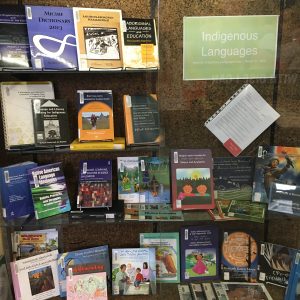 This month, we are putting the spotlight on Indigenous languages! Did you know that March 31 is National Indigenous Languages Day? Stop by the ground floor display case to check out some of our books both about and written in Indigenous languages.
This month, we are putting the spotlight on Indigenous languages! Did you know that March 31 is National Indigenous Languages Day? Stop by the ground floor display case to check out some of our books both about and written in Indigenous languages.
For individuals interested in a specific language, there are a number of dictionaries and grammars available, such as Learning Ojibwe: Anishinaabemowin Maajaamigad and Castel’s English-Cree Dictionary and Memoirs of the Elders. In addition to Indigenous language dictionaries and grammars, we’ve got a number of general books about Indigenous language use in the OISE Library collection. These include Native American Language Ideologies: Beliefs, Practices, and Struggles in Indian Country, Aboriginal Languages and Education: The Canadian Experience, and Indigenous Youth and Multilingualism: Language Identity, Ideology, and Practice in Dynamic Cultural Worlds. Additionally, some edited volumes such as Language, Learning, and Culture in Early Childhood: Home, School, and Community Contexts include chapters about Indigenous languages.
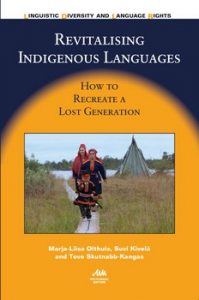 Language revitalization projects have received attention in recent years as communities work to grow speakers of Indigenous languages. The OISE Library collection contains several books about language revitalization research, such as Language Endangerment and Language Revitalization and Language Loyalty, Language Planning and Language Revitalization: Recent Writings and Reflections from Joshua A. Fishman. Furthermore, research and projects about Indigenous language revitalization in other parts of the world nevertheless bring with them information that may be applied to the Canadian context. This category includes titles such as Revitalising Indigenous Languages: How to Recreate a Lost Generation, which looks at Inari Saami in Finland. This doesn’t mean that we don’t also have case studies about Canadian languages, however! Remembering Inninimowin: The Language of the Human Beings and Cowboys, Indians, and Education: Regenerating Secwepemc Culture and Language, for example, both look at Indigenous language revitalization in a Canadian context.
Language revitalization projects have received attention in recent years as communities work to grow speakers of Indigenous languages. The OISE Library collection contains several books about language revitalization research, such as Language Endangerment and Language Revitalization and Language Loyalty, Language Planning and Language Revitalization: Recent Writings and Reflections from Joshua A. Fishman. Furthermore, research and projects about Indigenous language revitalization in other parts of the world nevertheless bring with them information that may be applied to the Canadian context. This category includes titles such as Revitalising Indigenous Languages: How to Recreate a Lost Generation, which looks at Inari Saami in Finland. This doesn’t mean that we don’t also have case studies about Canadian languages, however! Remembering Inninimowin: The Language of the Human Beings and Cowboys, Indians, and Education: Regenerating Secwepemc Culture and Language, for example, both look at Indigenous language revitalization in a Canadian context.
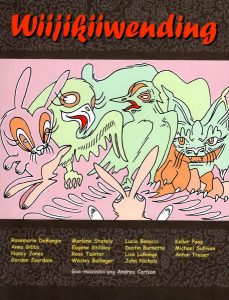 The OISE Library also has a robust collection of dual language children’s books in English and an Indigenous language. Our Ojibwe language collection, for example, includes picture books such as Waaboos Miinawaa Mkwa Zidens Gchi-Twaa Niizhwaaswi: Nbwaakaawin (“Rabbit and Bear Paws Sacred Seven: Wisdom”) as well as instructional books such as Things that Grow from the Ground: Ezaak’kiigin. We’ve also got several monolingual Ojibwe children’s books, including Mino-doodaading: Dibaajimowinan Ji-mino-ayaang, Naadamaading: Dibaajimowinan Ji-Nisidotaading, and Wiijikiiwending. Our Mohawk language collection, meanwhile, includes bilingual titles such as Tsi Ní:iot Tsi Ionatonní:’on Ne Taktsinén:nawen (“How the Butterflies Came to Be”), Tsítsho Tánon Tehahonhtané:ken Ká:kara (“The Story of the Fox and the Rabbit”), and Ratsenhanón:we Tánon Tehanonniá:khwa Ko’khó:wa (“Moth, the Fire Dancer”).
The OISE Library also has a robust collection of dual language children’s books in English and an Indigenous language. Our Ojibwe language collection, for example, includes picture books such as Waaboos Miinawaa Mkwa Zidens Gchi-Twaa Niizhwaaswi: Nbwaakaawin (“Rabbit and Bear Paws Sacred Seven: Wisdom”) as well as instructional books such as Things that Grow from the Ground: Ezaak’kiigin. We’ve also got several monolingual Ojibwe children’s books, including Mino-doodaading: Dibaajimowinan Ji-mino-ayaang, Naadamaading: Dibaajimowinan Ji-Nisidotaading, and Wiijikiiwending. Our Mohawk language collection, meanwhile, includes bilingual titles such as Tsi Ní:iot Tsi Ionatonní:’on Ne Taktsinén:nawen (“How the Butterflies Came to Be”), Tsítsho Tánon Tehahonhtané:ken Ká:kara (“The Story of the Fox and the Rabbit”), and Ratsenhanón:we Tánon Tehanonniá:khwa Ko’khó:wa (“Moth, the Fire Dancer”).
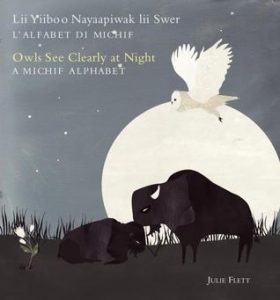 Languages from other parts of Canada are also represented in the OISE Library collection. A selection of these books are on display this month. From the Cree collection, you will find titles such as Wanisinwak Iskwêsisak: Awâsisasinahikanis (“Two Little Girls Lost in the Bush: a Cree Story for Children”) and Emily Whiskeychan e Ishi Memehch Ihtit (“Emily Whiskeychan’s Incredible Imagination”). Our Inuktitut books, meanwhile, include Trip to the Moon and Jaan aullaqsimanirijanga: unikkaaq inungnut nutaqqanut aanniaqaqtunut ilanginnullu (“John’s Tricky Journey”), which also includes an extensive bilingual appendix about navigating cancer treatments for parents and family. The Library also has a monolingual Inuktitut book, Qanuq pinngurnirmata: Inuit unikkaangit qanuq pinngurnirmangaata. From the Michif language collection, you will find titles such as Lii Yiiboo Nayaapiwak Lii Swer: L’alfabet di Michif (“Owls See Clearly at Night: A Michif Alphabet”) and Li Kaan di Sool: Aen Nistwayr di Michif li Taan Kayaash Taanishi aen Ishi Maykihk (“The Diamond Willow Walking Stick: A Traditional Métis Story About Generosity”).
Languages from other parts of Canada are also represented in the OISE Library collection. A selection of these books are on display this month. From the Cree collection, you will find titles such as Wanisinwak Iskwêsisak: Awâsisasinahikanis (“Two Little Girls Lost in the Bush: a Cree Story for Children”) and Emily Whiskeychan e Ishi Memehch Ihtit (“Emily Whiskeychan’s Incredible Imagination”). Our Inuktitut books, meanwhile, include Trip to the Moon and Jaan aullaqsimanirijanga: unikkaaq inungnut nutaqqanut aanniaqaqtunut ilanginnullu (“John’s Tricky Journey”), which also includes an extensive bilingual appendix about navigating cancer treatments for parents and family. The Library also has a monolingual Inuktitut book, Qanuq pinngurnirmata: Inuit unikkaangit qanuq pinngurnirmangaata. From the Michif language collection, you will find titles such as Lii Yiiboo Nayaapiwak Lii Swer: L’alfabet di Michif (“Owls See Clearly at Night: A Michif Alphabet”) and Li Kaan di Sool: Aen Nistwayr di Michif li Taan Kayaash Taanishi aen Ishi Maykihk (“The Diamond Willow Walking Stick: A Traditional Métis Story About Generosity”).
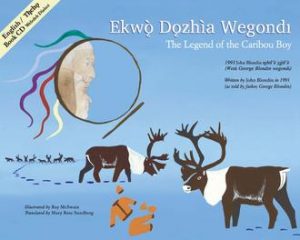 Still other Indigenous languages can also be found in the OISE Library collection. These include, for example, Muin aqq l’uiknek te’sijik ntuksuinu’k: Mi’kmawey tepkikewey musikiskey a’tukwaqn (“Muin and the seven bird hunters: a Mi’kmaw night sky story”) (Mi’kmaq), Ekwǫ̀ Dǫzhìa Wegondi (“The Legend of the Caribou Boy”) (Dogrib), B_a’naboy’ la_xa _Gwa’wina ‘M_akw_ala (“Beneath Raven Moon”) (Kwak’wala), and Kou-skelowh (“We are the people: a trilogy of Okanagan legends”) (Okanagan).
Still other Indigenous languages can also be found in the OISE Library collection. These include, for example, Muin aqq l’uiknek te’sijik ntuksuinu’k: Mi’kmawey tepkikewey musikiskey a’tukwaqn (“Muin and the seven bird hunters: a Mi’kmaw night sky story”) (Mi’kmaq), Ekwǫ̀ Dǫzhìa Wegondi (“The Legend of the Caribou Boy”) (Dogrib), B_a’naboy’ la_xa _Gwa’wina ‘M_akw_ala (“Beneath Raven Moon”) (Kwak’wala), and Kou-skelowh (“We are the people: a trilogy of Okanagan legends”) (Okanagan).
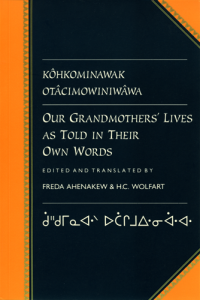 The Library’s bilingual books are not limited to children’s books, either! Currently on display are the memoirs portion of the Castel’s English-Cree Dictionary and Memoirs of the Elders and Kôhkominawak otâcimowiniwâwa (“Our grandmothers’ lives, as told in their own words”).
The Library’s bilingual books are not limited to children’s books, either! Currently on display are the memoirs portion of the Castel’s English-Cree Dictionary and Memoirs of the Elders and Kôhkominawak otâcimowiniwâwa (“Our grandmothers’ lives, as told in their own words”).
These books can be found in the glass display case on the ground floor of the OISE Library. A full list of resources on display is also available in the display case. All of these books are available to be checked out – please speak to staff at the circulation and reference desks if you need any assistance.
